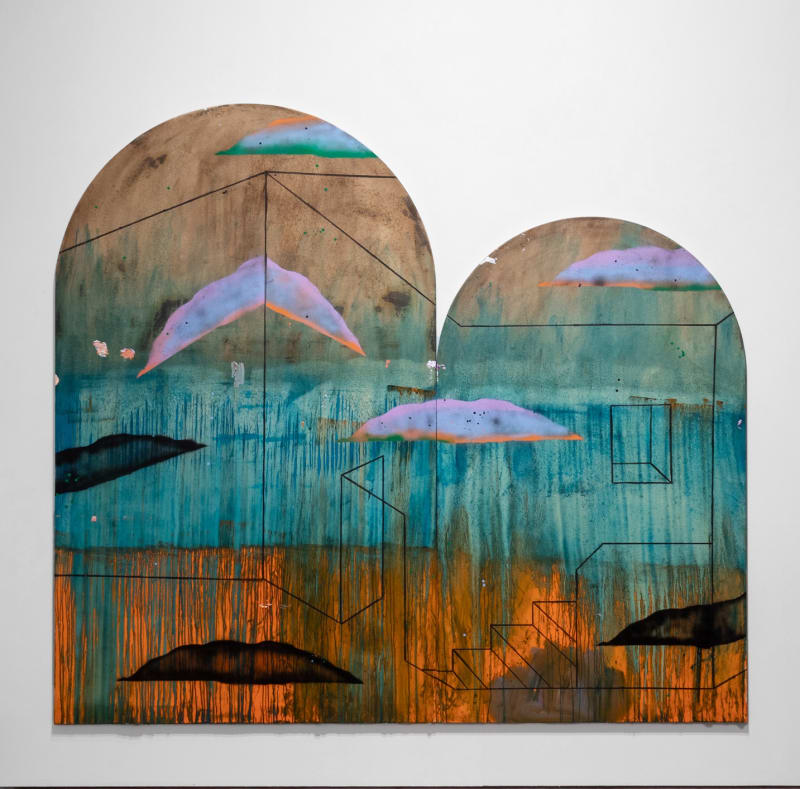Galerie Nathalie Obadia is delighted to present Benoît Maire's third solo exhibition, titled EITHER-OR, le temps romain, at the Faubourg Saint-Honoré gallery. Shown to the public for the first time, the exhibited works were realized by the artist in 2021-22, during his residency at the prestigious Villa Medici in Rome. These new paintings, created during his "Roman time," come together in an innovative exhibition that encourages a visual dialogue between art and philosophy.
The singularity of Benoît Maire's work stems from his multidisciplinary education. In fact, the artist holds a dual major in art and philosophy. His practice sits at the juncture of thought and matter: given the fact that words are inadequate at expressing theory, he adds plastic and visual openings. The exhibition EITHER-OR, le temps romain attests to this intersection. Hybrid alloys conjugate writing, symbols and motifs that attempt, by their combination, to probe the fundamental gap between saying and seeing.
The title of the exhibition, EITHER-OR, le temps romain, evokes this idea of an alternative, "a notion that we find again and again in the process of painting, but also at all levels of our existence," explains the artist. Screen-printed on one of the larger scale works of the exhibition, the combination of "Either" and "Or" connects two exclusive choices that require a decision. The words are arranged across a large checkerboard, resembling a logic matrix, which also suggests the idea of binarity, decision. In this composition, the written word melds with forms that the artist sources in art history. Saint John the Baptist's hand, borrowed from Rogier van der Weyden (left panel of the Braque Triptych, 1452, Louvre), materializes in certain paintings, as if to designate that which cannot be named. Benoît Maire thus creates playful movements where the complexity of the theory is solved in the image.
While Benoît Maire's usual visual lexicon can be found in his latest works, new elements result from the recent experimentations in his practice. Clouds are still present: since their first appearance in 2012 in the series Peintures de Nuages, they have evoked the softness of Chinese landscape paintings, impressionism, and the settings in Emil Nölde's "Fantasies." An invitation to daydream, accentuated by the new motif of the window, which is a potential opening that encourages contemplation. There is also a desire to run away suggested by the horse who travels across different planes and dimensions in certain of the exhibited works. For Benoît Maire, this is a movement of escape, recalling Shakespeare's Richard III, in which the king wishes to exchange the totality of his kingdom for a horse: "A horse! a horse! my kingdom for a horse!" As the artist posits, "the goal of the horse figure is to prioritize being over having, and for this inscription to be, to really be, it needs to escape."
The openings that appear in his work make us see new zones of perspective, inspired by the environment he frequented daily when he lived in Rome and by the painting Madonna and Child with a Donor by Antonio Solario. In this work by the Italian painter of the 15th-century Neapolitan school, the window at top right opens onto an idealized landscape, the drapery in the background suggests that it has been staged, and the Virgin's hands are arranged in the sign of a benediction. "At the time," says the artist, "books were not common; the paintings contained the important stories, and all their signs were linguistic." By borrowing the same elements, Benoît Maire does away with the divine experience, in favor of the mystique of modern art: windows, in their great economy of graphic means, open onto minimal art. Certain works by the artist derive inspiration from the religious perspective used by Italian primitives, while others borrow the rounded formats of Renaissance Roman architecture.
The diptychs attest to these architectural influences: the two panels draw inspiration from the half-moon format and are assembled into pairs. By combining them, the artist organizes the extension or rupture of his line, moving from one canvas to another. Each work in the exhibition seems to be an essential link in this disparate ensemble. The artist's paintings are deployed across the space and, at last, come together to form a unit. We should consider them "like a big family," says the artist.
While inscribing itself in the continuity of Renaissance forms by way of classical painting, Benoît Maire's oeuvre detonates with its extremely contemporary quality. The artist resorts to visual techniques that are both traditional (chromatic variations made with oil paint, impastos, glacis, knife painting, development of deep and vaporous colors) and contemporary (use of stencils and aerosol sprays, screen-printing, use of scotch tape). Benoît Maire is a painter of layers: his place is between philosophy and art, form and substance, while also exposing the traditional continuities and inevitable transformations of painting. This new exhibition thus presents vast terrains of experimentation, accumulating strata of different temporalities. Could the presence of the window motif symbolize the opening through which all of us have briefly tried to escape? Forever characterized by this ambivalent impetus, the breaches invite the viewer to introspect and contemplate the external landscape.
To commemorate this exhibition, Galerie Nathalie Obadia has published a series of photographs of Benoît Maire's studio, taken by Julien Carreyn, accompanied by a text by Italian art critic Stefano Chiodi.
